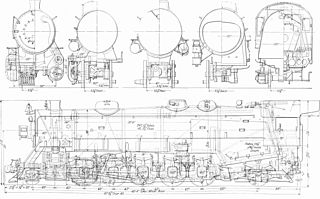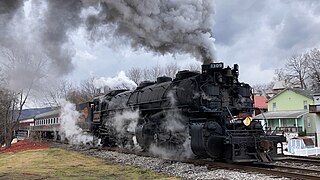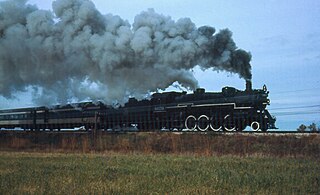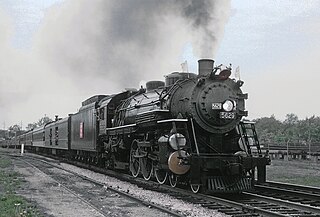Under the Whyte notation for the classification of steam locomotives, 2-10-0 represents the wheel arrangement of two leading wheels on one axle, ten powered and coupled driving wheels on five axles, and no trailing wheels. This arrangement was often named Decapod, especially in the United States, although this name was sometimes applied to locomotives of 0-10-0 "Ten-Coupled" arrangement, particularly in the United Kingdom. Notable German locomotives of this type include the war locomotives of Class 52.
Under the Whyte notation for the classification of steam locomotives by wheel arrangement, a 2-6-6-2 is a locomotive with one pair of unpowered leading wheels, followed by two sets of three pairs of powered driving wheels and one pair of trailing wheels. The wheel arrangement was principally used on Mallet-type articulated locomotives, although some tank locomotive examples were also built. A Garratt locomotive or Golwé locomotive with the same wheel arrangement is designated 2-6-0+0-6-2 since both engine units are pivoting.

The 2-6-6-6 is an articulated locomotive type with two leading wheels, two sets of six driving wheels and six trailing wheels. Only two classes of the 2-6-6-6 type were built. One was the "Allegheny" class, built by the Lima Locomotive Works. The name comes from the locomotive's first service with the Chesapeake and Ohio Railway beginning in 1941, where it was used to haul loaded coal trains over the Allegheny Mountains. The other was the "Blue Ridge" class for the Virginian Railway. These were some of the most powerful reciprocating steam locomotives ever built, at 7,500 hp, and one of the heaviest at 386 tons for the locomotive itself plus 215 tons for the loaded tender.
The USRA 0-8-0 was a USRA standard class of steam locomotive designed under the control of the United States Railroad Administration, the nationalized railroad system in the United States during World War I. This was the standard heavy switcher locomotive of the USRA types, and was of 0-8-0 wheel arrangement in the Whyte notation, or "D" in UIC classification.

The USRA Light Mikado was a USRA standard class of steam locomotive designed under the control of the United States Railroad Administration, the nationalized railroad system in the United States during World War I. This was the standard light freight locomotive of the USRA types, and was of 2-8-2 wheel arrangement in the Whyte notation, or 1′D1′ in UIC classification.

The USRA Heavy Mikado was a USRA standard class of steam locomotive designed under the control of the United States Railroad Administration (USRA), the nationalized railroad system in the United States during World War I. These locomotives were of 2-8-2 wheel arrangement in the Whyte notation, or 1′D1′ in UIC classification. A total of 233 locomotives were built to this plan for the USRA; postwar, it became a de facto standard design, which was built to the total of 957 locomotives including the USRA originals and all subsequent copies.

The USRA Heavy Santa Fe was a USRA standard class of steam locomotive designed under the control of the United States Railroad Administration, the nationalized railroad system in the United States during World War I. These locomotives were of 2-10-2 wheel arrangement in the Whyte notation, or 1′E1′ in UIC classification; this arrangement was commonly named "Santa Fe" in the United States. At the time, the Santa Fe was the largest non-articulated type in common use, primarily in slow drag freight duty in ore or coal service.

The USRA Light Santa Fe was a USRA standard class of steam locomotive designed under the control of the United States Railroad Administration, the nationalized railroad system in the United States during World War I. These locomotives were of 2-10-2 wheel arrangement in the Whyte notation, or 1′E1′ in UIC classification; this arrangement was commonly named "Santa Fe" in the United States. At the time, the Santa Fe was the largest non-articulated type in common use, primarily in slow drag freight duty in ore or coal service.

The USRA 2-6-6-2 is a standardized design of 2-6-6-2 Mallet locomotives developed by the United States Railroad Administration during World War I.

The USRA Light Pacific was a USRA standard class of steam locomotive designed under the control of the United States Railroad Administration, the nationalized railroad system in the United States during World War I. It was the standard light passenger locomotive of the USRA types, with a 4-6-2 wheel arrangement in the Whyte notation, or 2′C1′ in UIC classification.
The USRA 2-8-8-2 was a USRA standard class of steam locomotive designed under the control of the United States Railroad Administration, the nationalized railroad system in the United States during World War I. These locomotives were of 2-8-8-2 wheel arrangement in the Whyte notation, or (1'D)'D1' in UIC classification. A total of 106 locomotives were built to this plan for the USRA; postwar, it became a de facto standard design.
The USRA Heavy Pacific was a USRA standard class of steam locomotive designed under the control of the United States Railroad Administration, the nationalized railroad system in the United States during World War I. This was the standard heavy passenger locomotive of the USRA types, and was 4-6-2 wheel arrangement in the Whyte notation, or 2′C1′ in UIC classification.
The USRA Light Mountain was a USRA standard class of steam locomotive designed under the control of the United States Railroad Administration, the nationalized railroad system in the United States during World War I. This was the standard light freight locomotive of the USRA types, and was of 4-8-2 wheel arrangement in the Whyte notation, or 2′D1′ in UIC classification.
The USRA Heavy Mountain was a USRA standard class of steam locomotive designed under the control of the United States Railroad Administration, the nationalized railroad system in the United States during World War I. This was the standard light freight locomotive of the USRA types, and was of 4-8-2 wheel arrangement in the Whyte notation, or 2′D1′ in UIC classification.

Grand Trunk Western No. 4070 is an S-3-a class 2-8-2 USRA Light Mikado steam locomotive, and it was originally built by the American Locomotive Company (ALCO) in December 1918 for the Grand Trunk Railway (GTR) as No. 474. It was later re-numbered to 3734 by the Grand Trunk Western (GTW), after the GTR was absorbed into Canadian National (CN). In the late 1950s, the locomotive received a larger tender from an S-3-c class locomotive, and it was further re-numbered to 4070.

The Chicago and North Western Railway D Class was a class of 92 American 4-4-2 "Atlantic" locomotives. They were built by Schenectady Locomotive Works and by its corporate successor the American Locomotive Company between 1900 and 1908. In addition, the Chicago, St. Paul, Minneapolis and Omaha Railway bought seven, classifying them as class G-3

Reading 2100 is the prototype of the T-1 class 4-8-4 "Northern" type steam locomotives constructed in September 1945 for use by the Reading Company (RDG). Constructed from an earlier 2-8-0 "Consolidation" type locomotive built in May 1923 by the Baldwin Locomotive Works, No. 2100 pulled heavy freight and coal trains for the Reading until being retired from revenue service in 1956. Between 1961 and 1964, No. 2100 was used to pull the RDG's Iron Horse Rambles excursions alongside fellow T-1's Nos. 2124 and 2102. After the rambles ended, No. 2100 was sold along with No. 2101 in 1967 to a scrapyard in Baltimore, Maryland.

Union Pacific 5511 is a 2-10-2 “Santa Fe” type steam locomotive built by the Baldwin Locomotive Works in 1923 as part of the Union Pacific Railroad's TTT-6 class. It is the last remaining member of its class and the only remaining 2-10-2 to be operated by the Union Pacific.

Grand Trunk Western 5629 was a 4-6-2 K-4-a steam locomotive, which was a copy of the United States Railroad Administration's (USRA) Light Pacific design, built by American Locomotive Company (ALCO) in 1924, for the Grand Trunk Western Railroad. It was used to haul commuter passenger trains in Michigan until 1960, when it was purchased by Chicago-based railfan Richard Jensen, who used No. 5629 to pull several excursion trains in the Chicago area throughout the 1960s.

The Norfolk and Western Class Y3a was a class of 2-8-8-2 "Mallet" articulated steam locomotive with a total of 30 locomotives built for the Norfolk and Western Railway in 1923.













